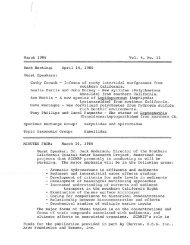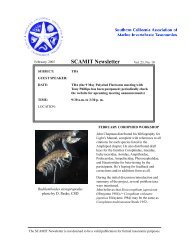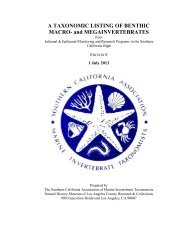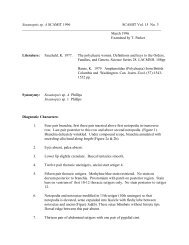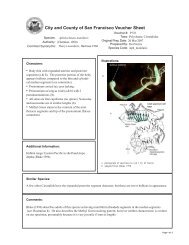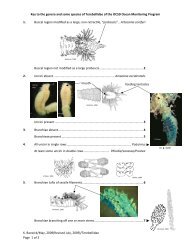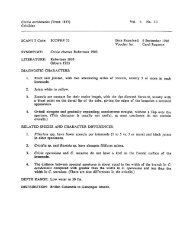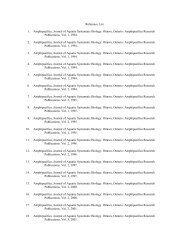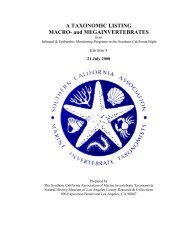SCAMIT Newsletter Vol. 23 No. 7 2004 November
SCAMIT Newsletter Vol. 23 No. 7 2004 November
SCAMIT Newsletter Vol. 23 No. 7 2004 November
Create successful ePaper yourself
Turn your PDF publications into a flip-book with our unique Google optimized e-Paper software.
<strong>No</strong>vember, <strong>2004</strong> <strong>SCAMIT</strong> <strong>Newsletter</strong> <strong>Vol</strong>. <strong>23</strong>, <strong>No</strong>. 7<br />
SUBJECT:<br />
GUEST SPEAKER:<br />
Corophoidae<br />
John Chapman<br />
DATE: 14 and 15 February <strong>2004</strong><br />
TIME: 9:30 a.m. to 3:30 p. m.<br />
LOCATION:<br />
Natural History Museum of Los Angeles County<br />
CORRECTION<br />
The last newsletter listed the next meeting as<br />
being on the Corophoidae on 14 February at<br />
the LACMNH with John Chapman as the guest<br />
speaker. All of this remains true, however, it is<br />
a two day workshop and the dates should be<br />
February 14 AND 15. Please note the change<br />
in your calendars and plans.<br />
8 NOVEMBER 04 MINUTES -<br />
AMPELISCID WORKSHOP<br />
Placiphorella mirablis Clark 1994<br />
Collected off San Diego, 1994<br />
Photo by K. Barwick, CSD<br />
Lisa Haney started the workshop by presenting<br />
the results of her investigation into Ampelisca<br />
hancocki Barnard 1954 and the validity of<br />
<strong>SCAMIT</strong>’s designation of the taxa as a<br />
complex. Confusion over the taxon can be<br />
traced to Dickinson (1982) where A. hancocki<br />
is described as having a tooth on the posterior<br />
ventral margin of coxae 1–3. Barnard (1954)<br />
describes A. hancocki as having “slits” on<br />
coxae 1 and 2, but not teeth. Representatives<br />
from the various agencies in attendance<br />
The <strong>SCAMIT</strong> <strong>Newsletter</strong> is not deemed to be a valid publication for formal taxonomic purposes.
<strong>No</strong>vember, <strong>2004</strong> <strong>SCAMIT</strong> <strong>Newsletter</strong><br />
<strong>Vol</strong>. <strong>23</strong>, <strong>No</strong>. 7<br />
(Hyperion, LACSD, MEC Analytical, CSD)<br />
had reviewed specimens from their own<br />
sampling efforts prior to the meeting and were<br />
all in agreement that specimens from the SCB<br />
had neither slits or teeth on the coxae, although<br />
Doug Deiner (MEC Analytical) reported<br />
occasionally finding teeth on the anterior<br />
coxae. In addition, Lisa had reviewed the type<br />
material, held at the Natural History Museum<br />
of Los Angeles County, and found that coxae<br />
1–3 of the type specimen were also without<br />
slits or teeth. The type material was in<br />
excellent condition: a relatively large<br />
specimen, intact and well preserved. Lisa noted<br />
that the specimen matched Barnard’s original<br />
description in all characters except for the<br />
presence of slits on coxae 1-2. Ron Velarde<br />
pointed out that the holotype material was<br />
collected from Port Parker, Costa Rica — a far<br />
cry from the SCB. Discussion of the issue<br />
continued and the group eventually decided<br />
that given the apparent variability of the coxal<br />
characters, and the absence of any other<br />
definitive characters to distinguish Dickinson’s<br />
description from Barnard’s, and apparently<br />
strong agreement of SCB specimens with the<br />
holotype, specimens from the SCB would be<br />
relegated to A. hancocki Barnard irrespective<br />
of the presence or absence of slits or teeth on<br />
coxae 1–3.<br />
With this issue resolved, the group moved on<br />
to the discussion of another problem taxon:<br />
Ampelisca cristata and its nominal subspecies<br />
A. cristata microdentata. Discussion of this<br />
taxon was prompted by early confusion of<br />
characters that reliably discriminate between<br />
the two forms, and Lisa’s concern of whether<br />
the two could be distinguished in her revised<br />
key. The first thought was to look at the<br />
distribution of the taxa and determine if there<br />
might be ecological data that would warrant<br />
their continued separation. Eric Nestler (CSD)<br />
provided handouts of the distribution of the<br />
two taxa over five years (1999–2003) of<br />
regional surveys of randomly selected stations<br />
off San Diego. The data showed general<br />
overlap in depth, with a fairly strong division<br />
2<br />
with the percentage of fine material in the<br />
sediments. A. cristata cristata tended to be<br />
distributed in samples consisting of coarser<br />
sediments (i.e., lower percentage of fine<br />
sediments), while A. cristata microdentata was<br />
more abundant at stations where the sediments<br />
contained more fine materials. Lisa Haney then<br />
provided a similar look at the distribution of A.<br />
cristata over a 30 year period, with the later<br />
five years including A. cristata microdentata<br />
abundance. The distribution of the two taxa<br />
was limited primarily to the 30m transect,<br />
although specimens were also collected along<br />
the 60m transect. Unfortunately, the<br />
distribution of the two taxa overlapped<br />
considerably and there was no apparent<br />
separation of the two subspecies based on<br />
particle size as was found in the SD data. The<br />
data from LACSD however did suggest a<br />
possible seasonal difference. These potential<br />
ecological separations will have to be<br />
investigated further once the taxonomic<br />
resolution (see below) is better understood by<br />
<strong>SCAMIT</strong> members operating in the SCB.<br />
Again, discussion among the representatives<br />
from the various agencies and consultants in<br />
attendance provided valuable information. The<br />
two taxa are known to co-occur in samples<br />
from northern Mexico to Ventura, in harbors<br />
and shallow shelf waters to about 60m.<br />
Members of the San Francisco laboratory<br />
currently do not discriminate between the two<br />
forms. However, a review of the one specimen<br />
brought by Dot <strong>No</strong>rris was determined to be A.<br />
cristata cristata. Don Cadien raised the issue<br />
that sympatric subspecies are inherently<br />
contradictory (like “compassionate<br />
conservatism”); the two could not be<br />
considered subspecies if they co-occurred. He<br />
suggested that they be separated at the level of<br />
species, rather than sub-species, or not at all.<br />
Most people in attendance were in general<br />
agreement that specimens with a small tooth on<br />
epimeron 3 also possessed a rounded (or at<br />
most, quadrate) epimeron 2, while those with a<br />
prominent tooth on epimeron 3 typically
<strong>No</strong>vember, <strong>2004</strong> <strong>SCAMIT</strong> <strong>Newsletter</strong><br />
<strong>Vol</strong>. <strong>23</strong>, <strong>No</strong>. 7<br />
possessed an acute corner or distinct tooth on<br />
epimeron 2. The problem is that the size or<br />
degree to which the postero-ventral corner of<br />
the epimera are produced vary. Several people<br />
expressed a method of first looking at<br />
epimeron 3. If that tooth was “small” they<br />
would confirm A. cristata microdentata by the<br />
absence of any tooth on epimeron 2. There was<br />
general agreement that the two taxa should be<br />
considered as separate, and left as such in the<br />
key. However, there was an obvious need to<br />
find additional characters that could be used to<br />
distinguish the two. Diener and Pasko proposed<br />
several characters in 1998 prior to the Bight’98<br />
regional survey (see Table 1 attached at the end<br />
of the newsletter). They offered to revisit these<br />
characters, as well as others, and attempt to<br />
find something that could be used reliably to<br />
distinguish between them.<br />
Next, the group considered Byblis veleronis<br />
and B. millsi. B. millsi, along with many other<br />
taxa, was also erected by Dickinson (1983) and<br />
has resulted in some confusion as to reliable<br />
characters to distinguish among various taxa.<br />
At the Bight’03 data resolution meeting, Dean<br />
Pasko noted that, with some exceptions, most<br />
participants acknowledged recognition of<br />
Byblis veleronis and B. millsi, although some<br />
confusion remained regarding which characters<br />
were appropriate to use in distinguishing the<br />
two. The characters used in the proposed key<br />
by Haney and Pasko were drawn from<br />
Dickinson (1983), Barnard (1954), and<br />
Chapman (in press). These characters however,<br />
have proven to be initially problematic. For<br />
example, San Diego tested the characters<br />
proposed by Haney and Pasko and found<br />
conflicting character states in equally sized<br />
males and females (7.5 mm and 7.0 mm,<br />
respectively) of B. millsi. For example, a male<br />
specimen had the following character states:<br />
antenna 1 flagellum reaching beyond the<br />
antenna 2 peduncle; coxae 2 & 3 were<br />
considered to be rounded or squared-off (at<br />
least not distinctly obliquely truncated); coxae<br />
1 and 2 were sub equal; the anterior edge of<br />
coxa 1 was straight; and the outer ramus of<br />
3<br />
uropod 1 was bare. In the accompanying<br />
female, the antenna 1 flagellum did NOT reach<br />
the end of antenna 2 peduncle; coxae 2 and 3<br />
were also rounded or squared-off (not distinctly<br />
truncated); coxa 1 was distinctly longer than 2;<br />
the anterior edge of coxa 1 was noticeably<br />
concave (at least proximally); and the outer<br />
ramus of uropod 1 had a row of dorso-lateral<br />
spines AND a row of lateral setae.<br />
Consequently Dean reviewed a number of<br />
additional specimens of the two species from<br />
San Diego collections side-by-side. He noticed<br />
that the length of the uropod 1 peduncle<br />
relative to the uropod 2 peduncle was<br />
distinctive between the two and seemed to hold<br />
for males and females. The question remains as<br />
to how well this character works with juvenile<br />
specimens, but the examination of many<br />
immature B. millsi specimens suggests that it<br />
should hold for smaller specimens. The<br />
pedunclular article of uropod 1 of B. veleronis<br />
is short and reaches to slightly beyond the midline<br />
of the uropod 2 peduncle, whereas in B.<br />
millsi the uropod 1 pedunclular article is long<br />
and reaches to the end of the uropod 2<br />
peduncle. These characters are clearly<br />
illustrated in Barnard (1954), Plate 37, Figure<br />
e, and Dickinson (1983), Figure 6, female and<br />
Figure 7, male urosome. Specimens of the two<br />
species were compared and everyone agreed<br />
that this was an easy character to see.<br />
After lunch, the group went through the<br />
proposed key of Haney and Pasko and<br />
discussed wording, character states, and took<br />
various specimens through the key. The<br />
discussion was lively and informative,<br />
resulting in many constructive suggestions.<br />
Some of the problem taxa raised during this<br />
session included Byblis bathyalis (included in<br />
key) vs. B. thyabilis (not in key). Dickinson<br />
(1983) commented that the two species are<br />
closely related and questioned whether or not<br />
they were distinct. John Byrne collected a<br />
specimen of B. bathyalis during the Bight’03<br />
survey. Unfortunately, the specimen wasn’t<br />
available for review, but will be reconsidered<br />
back at the CSD Laboratory. Another set of
<strong>No</strong>vember, <strong>2004</strong> <strong>SCAMIT</strong> <strong>Newsletter</strong><br />
<strong>Vol</strong>. <strong>23</strong>, <strong>No</strong>. 7<br />
closely related species was Ampelisca<br />
indentata and A. pugetica. Characters related to<br />
the condition and shape of the cephalon will be<br />
added to the key to assist in distinguishing<br />
between these species.<br />
Several specimens were reviewed. A specimen<br />
tentatively identified as A. shoemakeri by Carol<br />
Paquette was examined and determined to be<br />
A. hancocki. This raised the question of<br />
whether or not A. hancocki and A. shoemakeri<br />
were indeed different. This question was not<br />
satisfactorily resolved and needs to be<br />
reviewed. A specimen tentatively designated as<br />
A. macrocephala from the San Francisco<br />
laboratory was reviewed and determined to be<br />
A. careyi. Additionally, Lisa Haney discovered<br />
two specimens of A. mexicana during the QA/<br />
QC process of a Bight’03 sample from 36.7 m<br />
identified by Dean Pasko. The species had<br />
previously been unreported from the SCB by<br />
the member agencies so the discovery was<br />
significant and raised the question of whether<br />
the species had been missed previously,<br />
especially since it was found at a depth<br />
commonly sampled by monitoring agencies<br />
operating in the SCB. A. mexicana can be<br />
readily distinguished by the enlarged posteroventral<br />
lobe of pereopod 7, article 4.<br />
Unfortunately (for Dean) this species was not<br />
recorded by him in any of his samples. Also<br />
unfortunate, was the fact that the original data<br />
was unavailable at the time, so the group<br />
couldn’t determine what Dean had originally<br />
called these specimens.<br />
Finally, as the time for horrible LA traffic<br />
neared, the meeting rapidly wound down, but<br />
not without a flurry of two hastily distributed<br />
provisional voucher sheets. One distinguishing<br />
Americhelidium sp SD1 (Amphipoda:<br />
Oedicerotidae) from other forms of<br />
Americhelidium “shoemakeri” in the SCB.<br />
Dean found several tested and reliable<br />
characters to separate out this one unique<br />
species and revised his earlier voucher sheet to<br />
include these new characters. In addition, Dean<br />
distributed a voucher sheet for Pachychelium<br />
4<br />
sp SD1 (Amphipoda: Lysianassidae). This<br />
species has been collected twice and appeared<br />
to have some slight differences from P. davidis<br />
Stephensen 1925.<br />
Dean has since revised the sheets again and the<br />
two latest editions are attached at the end of<br />
this newsletter. Please replace earlier versions<br />
with those provided here.<br />
NEW LITERATURE – NOVEMBER 8<br />
Several pieces of literature were circulated at<br />
the meeting. Treasurer Cheryl Brantley brought<br />
forward two articles dealing with the status of<br />
taxonomy and its practitioners.<br />
Hopkins & Freckelton (2002) examine the<br />
downtrend not only in professional taxonomy,<br />
but also that in amateur taxonomy. Most of us<br />
production taxonomists in <strong>SCAMIT</strong> straddle<br />
the line, although some fall on one side or the<br />
other. The authors here use a definition of<br />
institutional association which would exclude<br />
many from the professional ranks per se. Their<br />
investigation focused on Britain and insects,<br />
but their results are applicable throughout the<br />
taxonomic community. They examined<br />
publications in the Entomological Monthly<br />
Magazine since 1918 and found long declines<br />
in the ranks of both amateur and professional<br />
taxonomists, with present activity levels much<br />
lower than in the past. They did see a recent<br />
upswing in amateur activity, but attribute this<br />
to active retirements of previous professionals<br />
rather than to work by new taxonomic<br />
“recruits”. This is, sadly, the same old story of<br />
decline covered by so many, and leads to the<br />
same end point: calls for increased emphasis on<br />
taxonomy. This is based on the essential nature<br />
of taxonomic expertise in conservation biology,<br />
which cannot effectively conserve what it<br />
cannot recognize. Let us hope the calls are<br />
heard and heeded this time.<br />
Taxonomic data quality and its evaluation is<br />
the subject of Stribling & Moulton (2003).<br />
They cover much the same ground as did<br />
Ranasinghe et al (2003). We have all grumbled,<br />
but ultimately complied, with the additional
<strong>No</strong>vember, <strong>2004</strong> <strong>SCAMIT</strong> <strong>Newsletter</strong><br />
<strong>Vol</strong>. <strong>23</strong>, <strong>No</strong>. 7<br />
effort at quality assurance and quality control<br />
in our regional monitoring. The above<br />
publications deal with why such additional<br />
effort is both valuable and warranted. Our<br />
existing methodologies serve to meet the<br />
requirements envisioned by Stribling &<br />
Moulton for appropriate quality control.<br />
Anyone who has already forgotten what those<br />
are should consult the Laboratory Manual for<br />
the Bight ’03 Regional Monitoring Program.<br />
Substantially the same sort of effort is to be<br />
expected in the next regional iteration.<br />
Don Cadien added a series of other<br />
publications to Cheryl’s list . The first, (Hughes<br />
et al 2000), deals with another aspect of EMAP<br />
monitoring. Our WEMAP program dealt with<br />
regional marine and estuarine assessments, but<br />
the EMAP project in this paper deals with<br />
inland surface waters. It is both interesting and<br />
instructive to see how the programs resemble<br />
and differ from one another. The authors make<br />
an interesting comparison of the expected cost<br />
of annual EMAP monitoring (5-10 million)<br />
reporting it equal to federal subsidies for<br />
promotion of the almond and popcorn<br />
industries overseas in 1997.<br />
Coleman (2003) provides information to assist<br />
publication of taxonomic papers. He provides a<br />
how-to guide to creation of perfect line<br />
drawings on computers. Since so many find<br />
electronic publication increasingly attractive,<br />
this technique is a boon. He suggests scanning<br />
original pencil drawings into the computer,<br />
then inking them digitally by use of a digitizer<br />
board through the computer’s USB port. The<br />
cost of the digitizer is not trivial, but it offers<br />
large increases in proficiency and throughput in<br />
production of figures.<br />
Secondary structure (habitat modifications<br />
produced by biological activity within or upon<br />
primary structure) is a fascinating aspect of<br />
community ecology. Cocito (<strong>2004</strong>) addresses<br />
the impact of secondary calcareous structure on<br />
community diversity and function in the<br />
marine environment. She discusses the entire<br />
spectrum of calcareous structures but her<br />
concentration is on those produced by<br />
bryozoans. While she found that in nearly all<br />
cases reviewed, the bryozoan bioconstruction<br />
resulted in increased diversity, she found it<br />
poorly quantified. Additional and more<br />
complete characterization of the fauna<br />
associated with bryozoan bioconstructions<br />
remains to be performed.<br />
Two papers (Dawson 2003; Marques & Collins<br />
<strong>2004</strong>) were circulated dealing with cnidarians.<br />
Dawson dealt with morphological variation in<br />
species of the jellyfish Aurelia. Over the past<br />
few years molecular data has pointed to the<br />
existence of multiple cryptic species in what<br />
was once considered only one or two species.<br />
Earlier workers had described multiple species,<br />
but these were later placed in synonymy as<br />
their boundaries proved too variable to retain<br />
their separation. New taxa are not designated<br />
here, but the nature of morphological variation<br />
in these sibling species is investigated as a<br />
preparation for future work on the genus. <strong>No</strong>te<br />
that we have several genetically separable<br />
species in the <strong>No</strong>rth East Pacific.<br />
The entire Medusozoa was analyzed<br />
cladistically by Marques & Collins. This<br />
subphylum of the Cnidaria contains all classes<br />
except the Anthozoa, which lack medusae in<br />
their life cycle. The authors propose, as a result<br />
of their analysis, a new class of cnidarians<br />
within the Medusozoa, the Staurozoa. This<br />
would contain two orders; the extant<br />
Stauromedusae, and the extinct Conulatae. This<br />
new class would bring to five the number of<br />
classes within Cnidaria: Anthozoa, Staurozoa,<br />
Cubozoa, Scyphozoa, and Hydrozoa. The<br />
authors provide descriptions of the 87<br />
characters used in the analysis, as well as the<br />
scoring of the characters for each of the<br />
considered groups. Their results largely agreed<br />
with earlier analyses based on molecular data.<br />
5
<strong>No</strong>vember, <strong>2004</strong> <strong>SCAMIT</strong> <strong>Newsletter</strong><br />
<strong>Vol</strong>. <strong>23</strong>, <strong>No</strong>. 7<br />
Molluscan phylogeny, specifically the<br />
euthyneuran gastropods, was analyzed by<br />
Grande et al (<strong>2004</strong>) based on molecular data<br />
(using a series of mitochondrial genes). Their<br />
analysis indicated that monophyly of the<br />
Opisthobranchia was rejected because of the<br />
inclusion of the pulmonate Siphonaria. The<br />
monophyly of the Pulmonata was strongly<br />
rejected, suggesting a reevaluation of<br />
morphological data (which supports<br />
monophyly of the Pulmonata) is necessary. It is<br />
heartening that the analysis showed the<br />
Opisthobranchia as monophyletic with the<br />
exception of the Siphonaria inclusion. More<br />
thorough taxon sampling of the various<br />
pulmonate clades might produce differing<br />
results in a re-analysis. Basommatophora and<br />
Systelommatophora were both represented by a<br />
single taxon in the present analysis. Perhaps<br />
even more enlightening would be a re-analysis<br />
combining multiple lines of evidence<br />
(including both molecular and morphological)<br />
and broader pulmonate taxon sampling in a<br />
single dataset.<br />
Using both 16S and 18S rDNA data combined<br />
with reproductive mode, Nygren & Sundberg<br />
(2003) examine the phylogeny of the autolytine<br />
syllids. They found the molecular and<br />
reproductive patterns to be congruent,<br />
suggesting a realignment of species among<br />
genera in some cases. Epigamous species of<br />
Autolytus would be placed in a new genus,<br />
while Autolytus species with other reproductive<br />
modes would move to Myrianida (which has<br />
priority). These and other nomenclatural<br />
actions are not performed in the present paper,<br />
but evidence in support of these actions is<br />
presented. A further paper will pursue the<br />
nomenclatural issues derived from the analysis.<br />
Occasionally, several investigators focus<br />
independently on a single taxon almost<br />
simultaneously. The lysianassoid amphipod<br />
genus Valettiopsis received such treatment<br />
from Serejo & Wakabara (2003) and Horton<br />
(<strong>2004</strong>). Our local fauna contains Valettiopsis<br />
dentata Holmes 1908, and both these papers<br />
6<br />
discuss the species. Horton provides additional<br />
information on the taxon, including illustration<br />
of the gnathopods, based on reexamination of<br />
the holotype. Both also provide keys to the<br />
genus world-wide, and both describe additional<br />
taxa within the genus. Fortunately Horton was<br />
aware of the earlier paper and did not<br />
redescribe one of their taxa as has happened in<br />
so many earlier overlapping publications.<br />
As we continually are forced to acknowledge<br />
the degree of variability of many character<br />
states in most species, what we see is poorly<br />
assessed. It is difficult to grasp under these<br />
circumstances how much variation may lurk<br />
undetected in local populations. While certain<br />
characters may be almost invariate through a<br />
population, others may vary widely with no<br />
apparent environmental cause. Within and<br />
between population variation in the distribution<br />
and abundance of setae in the isopod Saduria<br />
entomon is reported by Lajus et al (2003).<br />
While this is not a taxon which we encounter<br />
locally, a study such as this helps frame the<br />
questions we need answered for our own local<br />
populations.<br />
NOVEMBER 17 04 MINUTES<br />
The meeting began with our President<br />
discussing upcoming <strong>SCAMIT</strong> meetings. I will<br />
not bother to list those here as they have been<br />
covered in previous newsletters and are posted<br />
on our website.<br />
A non-<strong>SCAMIT</strong> meeting of some interest to<br />
members is the Southern California Academy<br />
of Sciences (SCAS) Annual Meeting. It will be<br />
held from May 20-21, 2005 at Loyola<br />
Marymount University in Los Angeles. There<br />
will be diverse symposia covering such<br />
subjects as Nearshore Reef Ecology, Wetland<br />
Ecology, and Watersheds and Pollution, to<br />
name a few. Please see their website for more<br />
information.<br />
http://scas.jsd.claremont.edu/
<strong>No</strong>vember, <strong>2004</strong> <strong>SCAMIT</strong> <strong>Newsletter</strong><br />
<strong>Vol</strong>. <strong>23</strong>, <strong>No</strong>. 7<br />
Don Cadien then discussed a new trend in<br />
monitoring. We are starting to see less of an<br />
emphasis on “end of pipe” sampling and more<br />
on new types of programs directed at<br />
answering specific research questions. This<br />
was the recommendation of the National<br />
Research Council based on their review of<br />
monitoring in southern California. It was<br />
picked up and incorporated in the Model<br />
Monitoring Program, and adopted by the State<br />
Water Quality Control Board. This approach<br />
may affect the requirements of newly issued<br />
discharge permits.<br />
We then welcomed the guest speaker for the<br />
day, Roger Clark. Roger routinely publishes a<br />
field guide for the National Marine Fisheries<br />
Service entitled: “West Coast Shelf and Slope<br />
Invertebrates. Juan de Fuca Strait to Baja<br />
California. NMFS Trawl Field Guide”.<br />
Roger started his presentation for the day by<br />
showing us a wonderful slide show of all the<br />
various species he encounters. He trawls with<br />
NMFS and samples from Canada to Baja<br />
California within a depth range of 200-1200m.<br />
He started with slides of sponges. Some<br />
species in the northern Pacific actually form a<br />
“reef-like” system. One reef-building species,<br />
Aphrocallistes vastus has suffered from<br />
anthropogenic impact in the Oregon/<br />
Washington area and most of the reefs now<br />
consist of dead skeleton. However, further<br />
north, in Alaska and British Columbia there are<br />
still massive, live reefs created by this sponge.<br />
Roger pointed out that either dead or alive, the<br />
sponge provides a good habitat for other<br />
invertebrate species.<br />
He proceeded through all the taxa from this<br />
point and I stopped trying to write down the<br />
name of every species he showed as the<br />
newsletter would, at that point, simply be a<br />
listing of species. The slides themselves were<br />
the informative aspect and unfortunately, I<br />
can’t reproduce them here.<br />
However, by the end of the slide show, many<br />
members present had noticed a slight “paucity”<br />
in some of his slides with regards to our very<br />
southern friends at this end of the pacific.<br />
Based on our comments, Roger has a “Wanted”<br />
list and would like live photos of the following<br />
species:<br />
Crustacea - Sicyonia penicillata, Schmittius<br />
politus, Pagurus spilocarpus (he photographed<br />
one in CSD’s display tank so this is potentially<br />
no longer needed), Cancer antennarius and C.<br />
jordani<br />
Molluscs – Octopus rubescens and O. veligero<br />
(M. Lilly gave him a photo)<br />
Echinoderms – Luidia armata, Astropecten<br />
ornatissimus (M. Lilly gave him a photo, but if<br />
someone has a better one it would be<br />
appreciated), Ophiopholis bakeri (M. Lilly<br />
provided a photo, but the quality was<br />
mediocre), Ophiura luetkenii, Dendraster<br />
terminalis (he photographed a preserved<br />
specimen, but a live photo would be<br />
preferable), and Parastichopus sp LA 1.<br />
Roger will be returning to San Diego, probably<br />
this summer, to go on trawls and try to catch<br />
some of these more elusive animals on film. If<br />
any of you reading this have good, live images<br />
of the animals mentioned, I’m sure Roger<br />
would love to hear from you.<br />
After the slide show we all broke for lunch,<br />
agreeing to start the Chiton session afterwards.<br />
Roger spent the afternoon giving a wonderful<br />
slide show on “chitons he has known”. Again,<br />
although I took copious notes, the information<br />
was mostly anecdotal and related to the slide<br />
being viewed at the time. He discussed species<br />
ranging from Baja up through northern<br />
California and Oregon and ranging from the<br />
intertidal to subtidal in habitat. I shall not<br />
provide a species list here (if someone really<br />
wants it they can email me and I will provide a<br />
7
<strong>No</strong>vember, <strong>2004</strong> <strong>SCAMIT</strong> <strong>Newsletter</strong><br />
<strong>Vol</strong>. <strong>23</strong>, <strong>No</strong>. 7<br />
copy for them). Roger, I believe, is working on<br />
a guide to the chitons which is still in press.<br />
Keep an eye out for it.<br />
- M. Lilly, CSD<br />
NEW LITERATURE - NOVEMBER 17<br />
Four papers were distributed to the attendees<br />
for their consideration. One (Christensen <strong>2004</strong>)<br />
dealt with reports of one of our common <strong>No</strong>rth<br />
East Pacific ophiuroids, Ophiactis simplex,<br />
from Texas. The species was first noted there in<br />
2001, and observations on substrate, size,<br />
appearance, and regeneration state (the species<br />
is fissiparous) were kept from that point to the<br />
present publication. The identity of the<br />
specimens was verified by Dr. Gordon Hendler<br />
at NHMLAC, therefore this is not a mistaken<br />
report. Method of introduction to the Gulf<br />
Coast is unknown.<br />
The other three papers dealt with phylogeny of<br />
mollusks. Klussmann-Kolb (<strong>2004</strong>) examined<br />
phylogeny of the sea-hare family Aplysiidae.<br />
She found the traditional morphological<br />
division of the family into sections<br />
Longicommissurata and Brevicommissurata<br />
(incorrectly characterized in the paper as<br />
Suborders) no longer supportable. The four<br />
subfamilies of Aplysiidae suggested by<br />
Beeman are retained in this analysis. In several<br />
respects this morphology and histology based<br />
analysis differed from a previous one based on<br />
molecular evidence, suggesting that more work<br />
on character selection needs to be undertaken.<br />
Molecular phylogenetic analysis of<br />
Scaphopoda using 18S rDNA sequences was<br />
reported by Steiner & Dreyer (2003). The<br />
authors attempted to achieve two goals;<br />
definition of relationships between families<br />
within the Scaphopoda, and a decision as to the<br />
relationship of the Class to other Classes in the<br />
Mollusca. They concluded that their taxon<br />
sampling was not complete enough to clarify<br />
within class relationships, but found support<br />
for a Scaphopoda+Cephalopoda concept of<br />
higher level molluscan relationships. This<br />
corresponds to the Helcionellid concept<br />
8<br />
espoused by Waller (1998), and offers no<br />
support for competing hypotheses of class<br />
relationships within Mollusca. Another<br />
attempt, with broader taxon sampling will<br />
undoubtedly be forthcoming from these or<br />
other authors to decide the issue of within<br />
scaphopod family relationships.<br />
As part of the specialty taxonomy assessments<br />
for Bight ’03, Kelvin Barwick and Don Cadien<br />
have been working on the aplacophore<br />
mollusks. One of the most difficult parts of this<br />
work has been trying to determine what the<br />
higher classification of the group should be.<br />
There are two major competing schools of<br />
thought; one headed by Salvini-Plawen, and<br />
the other by Scheltema. Both agree the<br />
Caudofoveata (chaetodermatomorphs) and the<br />
Solenogastres (neomeniomorphs) are quite<br />
different, but placement of the two groups<br />
relative to the rest of the Mollusca differs<br />
widely between these schools. Salvini-Plawen<br />
(2003) gives the most recent discussion of<br />
evidence for his position on higher<br />
classification. Another synthesis of evidence in<br />
support of the opposing view will undoubtedly<br />
be out shortly from Scheltema. Both have<br />
considerable evidence to support their point of<br />
view, leaving most of us in a quandary: who<br />
should I follow I’ll be watching for the next<br />
salvo from each side, and plan to reach some<br />
sort of decision for Edition 5 of the <strong>SCAMIT</strong><br />
Taxonomic Listing. The new edition will have<br />
substantial representation of the aplacophorans<br />
for the first time based on the taxa taken in<br />
Bight ’03 and other recent deeper water<br />
samplings by contributing agencies.<br />
- By the way, send any additions or changes to<br />
the Edition 4 Taxonomic Listing to<br />
dcadien@lacsd.org for inclusion in Edition 5.<br />
TROPICAL SPONGE WORKSHOP<br />
The Smithsonian Tropical Research Institute,<br />
Bocas Research Station Presents A Short-<br />
Course In TAXONOMY AND ECOLOGY OF<br />
CARIBBEAN SPONGES August 15 - 25,<br />
2005
<strong>No</strong>vember, <strong>2004</strong> <strong>SCAMIT</strong> <strong>Newsletter</strong><br />
<strong>Vol</strong>. <strong>23</strong>, <strong>No</strong>. 7<br />
Bocas Research Station, Bocas del Toro,<br />
Panama.<br />
Registration Fee: $400 (some fellowships are<br />
available).<br />
Instructors: Dr. Cristina Diaz, Smithsonian<br />
Institution,and Dr. Robert W. Thacker,<br />
University of Alabama at Birmingham<br />
Over 100 species of marine sponges have been<br />
reported in the Bocas del Toro region of<br />
Panama. This course will focus on<br />
morphological taxonomy, enabling field<br />
identification of the common Caribbean<br />
species. We will also conduct field surveys to<br />
provide baseline data for conservation at the<br />
Bocas Research Station and in the Isla<br />
Bastimentos marine reserve. In addition,<br />
students will complete independent projects<br />
aimed at stimulating interest in conducting<br />
future research at the Bocas Research Station.<br />
Application: This course is directed towards<br />
graduate students and advanced Licenciado<br />
candidates and will be conducted in English.<br />
Please e-mail your CV, 1 letter of<br />
recommendation, and a 1-2 page statement<br />
explaining your background and reasons for<br />
taking the course to Dr. Rachel Collin at:<br />
CollinR@naos.si.edu before March 1, 2005.<br />
Enrollment is limited to 10 students. For more<br />
information see:<br />
http://striweb.si.edu/taxonomy/<br />
BIBLIOGRAPHY (FOR BOTH MEETINGS)<br />
Barnard, J. Laurens. 1954. Amphipoda of the Family Ampeliscidae Collected in the Eastern<br />
Pacific Ocean by the Velero III and Velero IV. Allan Hancock Pacific Expeditions 18(1):<br />
1-137.<br />
Christensen, Ana Beardsley. <strong>2004</strong>. A new distribution record and notes on the biology of the<br />
brittle star Ophiactis simplex (Echinodermata: Ophiuroidea) in Texas. Texas Journal of<br />
Science 56(2):175-79.<br />
Cocito, Silvia. <strong>2004</strong>. Bioconstruction and biodiversity: their mutual influence. Scientia Marina<br />
68:137-44.<br />
Coleman, Charles Oliver. 2003. “Digital Inking”: how to make perfect line drawings on<br />
computers. Organisms Diversity & Evolution 3, Electronic Supplement 14:1-14.<br />
Dawson, M. N. 2003. Macro-morphological variation among cryptic species of the moon<br />
jellyfish, Aurelia (Cnidaria: Scyphozoa). Marine Biology 143(2):369-79.<br />
Dickinson, John J., Conlan, Kathleen E., Bousfield, E. L., and Jarrett, N. E. 1982. Studies on<br />
Amphipod Crustaceans of the <strong>No</strong>rtheastern Pacific Region. Family Ampeliscidae, Genus<br />
Ampelisca. National Museums of Canada <strong>No</strong>.10:1-39.<br />
Grande, Cristina, José Templado, J. Lucas Cervera, and Rafael Zardoya. <strong>2004</strong>. Molecular<br />
phylogeny of Euthyneura (Mollusca: Gastropoda). Molecular Biology and Evolution<br />
21(2):303-13.<br />
Hopkins, G. W., and R. P. Freckleton. 2002. Declines in the numbers of amateur and<br />
professional taxonomists: implications for conservation. Animal Conservation 5:245-<br />
249.<br />
Horton, Tammy. <strong>2004</strong>. Revision of the amphipod genus Valettiopsis Holmes, 1908 (Crustacea:<br />
Lysianassoidea), with the addition of three new species. Journal of Natural History<br />
38 (14):1735-55.<br />
9
<strong>No</strong>vember, <strong>2004</strong> <strong>SCAMIT</strong> <strong>Newsletter</strong><br />
<strong>Vol</strong>. <strong>23</strong>, <strong>No</strong>. 7<br />
Hughes, R. M., S. G. Paulsen, and J. L. Stoddard. 2000. EMAP-Surface Waters: a<br />
multiassemblage, probability survey of ecological integrity in the U.S.A. Hydrobiologia<br />
422/4<strong>23</strong>:429-443.<br />
Klussmann-Kolb, Annette. <strong>2004</strong>. Phylogeny of the Aplysiidae (Gastropoda, Opisthobranchia)<br />
with new aspects of the evolution of seahares. Zoologica Scripta 33, no. 5:439-62.<br />
Lajus, Dmitry, Monika Ciostek, Malgorzata Makowiecka, and Tadeusz Sywula. 2003.<br />
Geographic and ontogenetic patterns of chaetotaxy variation in glacial relict Saduria<br />
entomon (L.) (Crustacea, Isopoda): inter-population, inter-individual and intra-individual<br />
variations (Fluctuating asymmetry). Annales Zoologici Fennici 40(5):411-29.<br />
Marques, Antonio C., and Allen G. Collins. <strong>2004</strong>. Cladistic analysis of Medusozoa and cnidarian<br />
evolution. Invertebrate Biology 1<strong>23</strong>(1):<strong>23</strong>-42.<br />
Nygren, Arne, and Per Sundberg. 2003. Phylogeny and evolution of reproductive modes in<br />
Autolytinae (Syllidae, Annelida). Molecular Phylogenetics and Evolution 29(2):<strong>23</strong>5-49.<br />
Ranasinghe, J. Ananda, David E. Montagne, Steven B. Weisberg, Mary Bergen, and Ronald G.<br />
Velarde. 2003. Variability in the identification and enumeration of marine benthic<br />
invertebrate samples and its effect on benthic assessment measures. Environmental<br />
Monitoring and Assessment 81:199-206.<br />
Salvini-Plawen, Luitfried von. 2003. On the phylogenetic significance of the aplacophoran<br />
Mollusca. Iberus 21(1):67-97.<br />
Serejo, Christiana S., and Yoko Wakabara. 2003. The genus Valettiopsis (Crustacea,<br />
Gammaridea, Lysianassoidea) from the southwestern Atlantic, collected by the RV<br />
Marion Dufresne. Zoosystema 25(2):187-196.<br />
Steiner, Gerhard, and Hermann Dreyer. 2003. Molecular phylogeny of Scaphopoda (Mollusca)<br />
inferred from 18S rDNA sequences: support for a Scaphopoda-Cephalopoda clade.<br />
Zoologica Scripta 32(4):343-56.<br />
Stribling, J. B., S. R. Moulton II, and G. T. Lester. 2003. Determining the quality of taxonomic<br />
data. Journal of the <strong>No</strong>rth American Benthological Society 22(4):621-631.<br />
Waller, Thomas R. 1998. Origin of the molluscan class Bivalvia and a phylogeny of major<br />
groups. Pp. 1-47 IN: P. A. Johnston & J. W. Haggart (eds.). Bivalves: an Eon of<br />
Evolution – Paleobiological Studies Honoring <strong>No</strong>rman D. Newell. University of Calgary<br />
Press; Calgary, Canada.<br />
10
<strong>No</strong>vember, <strong>2004</strong> <strong>SCAMIT</strong> <strong>Newsletter</strong><br />
<strong>Vol</strong>. <strong>23</strong>, <strong>No</strong>. 7<br />
Please visit the <strong>SCAMIT</strong> Website at: http://www.scamit.org<br />
<strong>SCAMIT</strong> OFFICERS:<br />
If you need any other information concerning <strong>SCAMIT</strong> please feel free to contact any of the<br />
officers at their e-mail addresses:<br />
President Kelvin Barwick (619)758-<strong>23</strong>37 kbarwick@sandiego.gov<br />
Vice-President Leslie Harris (213)763-3<strong>23</strong>4 lharris@nhm.org<br />
Secretary Megan Lilly (619)758-<strong>23</strong>36 mlilly@sandiego.gov<br />
Treasurer Cheryl Brantley (310)830-2400x5500 cbrantley@lacsd.org<br />
Back issues of the newsletter are available. Prices are as follows:<br />
<strong>Vol</strong>umes 1 - 4 (compilation).................................$ 30.00<br />
<strong>Vol</strong>umes 5 - 7 (compilation).................................$ 15.00<br />
<strong>Vol</strong>umes 8 - 15 ................................................ $ 20.00/vol.<br />
Single back issues are also available at cost.<br />
The <strong>SCAMIT</strong> newsletter is published monthly and is distributed freely through the web site at<br />
www.scamit.org. Membership is $15 for the electronic copy available via the web site and $30<br />
to receive a printed copy via USPS. Institutional membership, which includes a mailed printed<br />
copy, is $60. All new members receive a printed copy of the most current edition of “A<br />
Taxonomic Listing of Soft Bottom Macro- and Megainvertebrates … in the Southern California<br />
Bight.” The current edition, the fourth, contains 2,067 species with partial synonyms. All<br />
correspondences can be sent to the Secretary at the email address above or to:<br />
<strong>SCAMIT</strong><br />
C/O The Natural History Museum, Invertebrate Zoology<br />
attn: Leslie Harris<br />
900 Exposition Boulevard<br />
Los Angeles, California, 90007
Epimeron 3<br />
Ampelisca cristata cristata<br />
postero-ventral corner with relatively large<br />
broad, acute tooth<br />
Ampelisca cristata microdentata<br />
postero-ventral corner with very small tooth<br />
Epimeron 2 postero-ventral corner acutely produced postero-ventral corner quadrate to rounded<br />
Head<br />
produced antero-distally into small “dome”<br />
(e.g., similar to A. careyi, but smaller)<br />
unproduced antero-distally<br />
Urosomal crest<br />
rounded on the ends, middle portion<br />
horizontal<br />
less rounded on ends, posterior portion higher<br />
than anterior<br />
Pereopod 7 basis squared along ventral margin basis with more rounded ventral margin<br />
Gills<br />
narrowed distally and relatively small (see<br />
J.J. Dickinson, 1982: Fig 20, A.<br />
brevisimulata or A. hessleri)<br />
cylindrical (i.e., not narrowed distally) and<br />
relatively large (see J.J. Dickinson, 1982: Fig 20,<br />
A. cristata)<br />
Table 1. Morphological characters which may be used to differentiate Ampelisca cristata<br />
cristata and A. cristata microdentata. The top three characters (in bold) appear to be the<br />
most reliable and easily distinguished characters. A more detailed review of both species<br />
is required to confirm the reliability of the secondary characters. Compiled by Doug<br />
Deiner (MEC Analytical) and Dean Pasko (CSDMWWD).
City of San Diego<br />
PROVISIONAL SPECIES VOUCHER SHEET<br />
Provisional Name: Americhelidium sp SD1 Taxon: Amphipoda: Oedicerotidae Taxonomist: Dean Pasko<br />
Authority:<br />
Date: 5 March 2001; Revised: 1 February 2005<br />
Common Synonyms:<br />
Specimen(s): STATION DATE DEPTH STORAGE LOCATION VIAL#<br />
Americhelidium shoemakeri Type A ITP Reg. 2727 7/10/00 152 ft dp<br />
2729 7/6/00 142 ft dp<br />
Characters:<br />
Generally similar in form to Americhelidium shoemakeri<br />
(Mills 1962) and A. rectipalmum (Mills 1962).<br />
Illustrations:<br />
Pleon<br />
Rostrum downturned at ~90 o , tip of rostrum reaching distal<br />
end of peduncular article 1, antenna 1<br />
Eyes fused dorsally, filling much of anterior portion of head,<br />
but not extending onto rostrum<br />
Mandibular palp, article 3
City of San Diego<br />
PROVISIONAL SPECIES VOUCHER SHEET<br />
Provisional Name: Americhelidium sp SD1 Taxon: Amphipoda: Oedicerotidae Taxonomist: Dean Pasko<br />
Authority:<br />
Date: 5 March 2001; Revised 1 February 2005<br />
Common Synonyms:<br />
Americhelidium shoemakeri Type A<br />
Related Species & Other Comments:<br />
This species is one of several forms of Americhelidium shoemakeri complex present in shelf waters off Point Loma<br />
and Imperial Beach, CA. Americhelidium sp SD1 can be distinguished from the other forms of the complex by a<br />
suite of characters, the most reliable of which include: the presence of distinct, paired setae on the pleonites that are<br />
typically missing in other members of the A. shoemakeri complex; a distinctly more robust gnathopod 2 propod (L:<br />
W = 5.5 vs 7.5 in A. shoemakeri) that is sparsely setose along the dorsal and ventral margins (1–4 setae vs 5–10 in A.<br />
shoemakeri); the presence of one or two distinctively long distal setae on the propod that run the length of dactyl (vs<br />
City of San Diego<br />
PROVISIONAL SPECIES VOUCHER SHEET<br />
Provisional Name: Pachychelium sp SD1 Taxon: Lysianassidae Taxonomist: D. Pasko / E. Nestler<br />
Authority:<br />
Date: 7 April 2003; Revised 1 February 2005<br />
Common Synonyms:<br />
Specimen(s): STATION DATE DEPTH STORAGE LOCATION VIAL#<br />
B-11 (2) 22-Jan-03 88 m CSD-Voucher Collection<br />
B’03 Sta 4029 21-Jul-03 75 m CSD-B’03 V#4737.1<br />
Characters:<br />
Small, elongate specimen (much like Prachynella or<br />
Pachynus)<br />
Illustrations: Pachychelium sp SD1<br />
Gnathopod 1<br />
Maxilliped palp 3-articulate; inner plate absent<br />
Gnathopod 1 uniquely shaped with carpus attached<br />
to hind margin of enlarged propodus (see figure);<br />
propod slightly produced at antero-distal margin of<br />
palm; basis and ischium not greatly enlarged; coxa<br />
large, broader than deep, with blunt antero-distal<br />
tooth<br />
Gnathopod 2 reduced, dactyl small, vestigial<br />
Coxa 4 similar to coxa 1–3, not excavate and without<br />
lobe<br />
Pereopod 7, similar in shape to pereopods 5 and 6;<br />
merus postero-distally produced; basis broadly<br />
rounded<br />
Pleon, epimeron 2 with blunt tooth; epimeron 3<br />
rounded<br />
Uropodal rami naked; Ur3 rami subequal, inner ramus<br />
composed of two articles, the distal-most being the<br />
smallest<br />
Telson ordinary, broadly rounded with one pair of<br />
disto-lateral setae<br />
Pereopod 7<br />
Telson Uropod 3<br />
Pachychelium davidis (from Barnard 1969)<br />
whole animal & gnathopod 1<br />
Related Species & Other Comments:<br />
The uniquely shaped first gnathopod distinguishes this species as being closely related to the Acheronia and Pachychelium<br />
genera of the Pachynid group (see Lowry 1984). It differs from A. pegasus Lowry 1984 in the absence of an anteroventral<br />
lobe on coxa 4 and the uni-articulate inner ramus of uropod 3, which is approximately 1/4 the length of the outer.<br />
It appears to be more closely aligned to Pachychelium davidis Stephensen 1925 and P. antarcticum Schellenberg 1926.<br />
It differs from the former in posessing an antero-distal process on the propodus and coxa of gnathopod 1, as well as the<br />
postero-distal process on the merus of pereopod 7. It differs from P. antarcticum by the absence of small inner plates on<br />
the maxilliped. Pachychelium sp SD1 is also intermediate between P. schellenbergi Lowry 1984 and P. nichollsi Lowry<br />
1984 for some characters (e.g., size of basis and ischium of gnathopod 1 and relative shape of pereopods 5–7), but differs<br />
from both by the 3-articulate maxilliped palp.<br />
Two important character states could not be verified due to the condition of the specimens examined. The teeth of the<br />
outer plate of maxilla 1 could not be reliably distinquished as smooth or spined, and the presence or absence of a complex<br />
spine on gnathopod 1 remains in question. Additional material is required to confirm these character states. Pachychelium<br />
has been reported from the Arctic and Antarctic, so its presence in southern California requires careful consideration.



